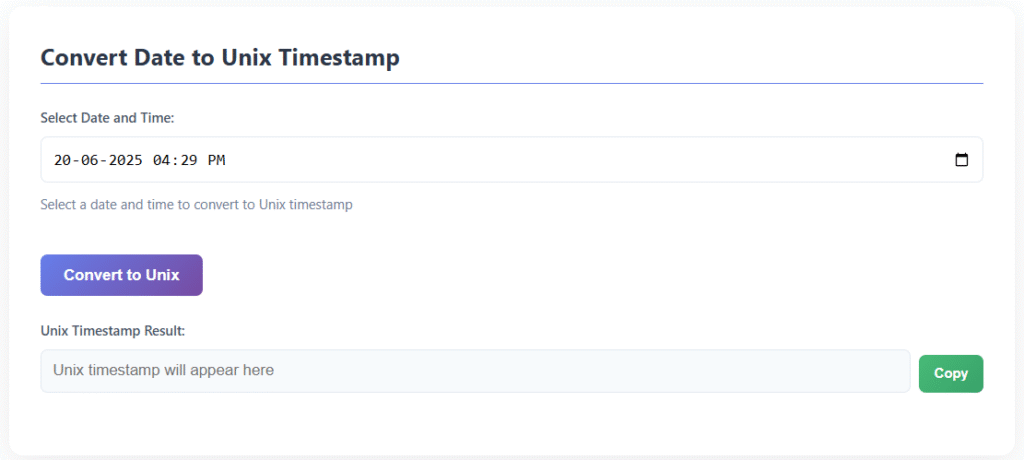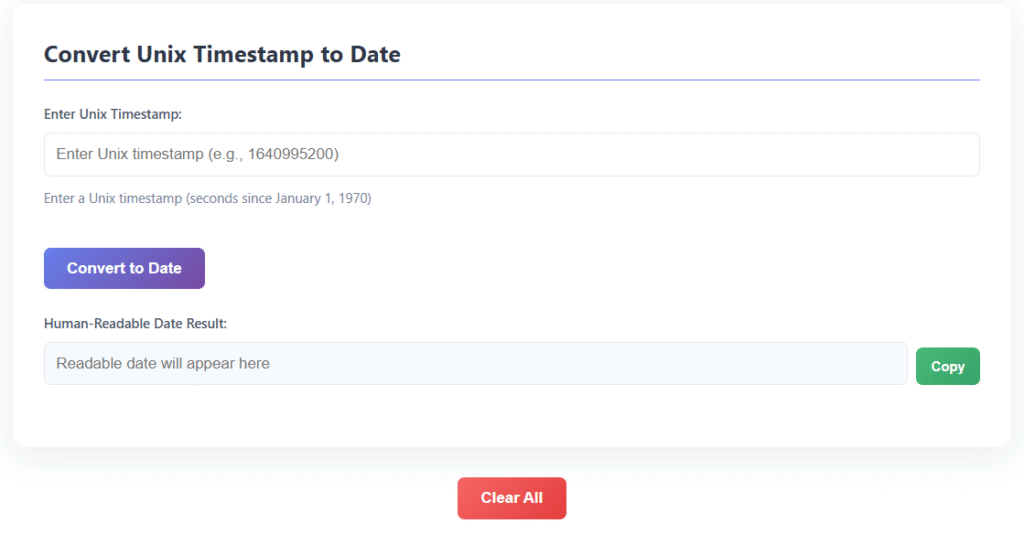Ever looked at a strange 10-digit number like “1718870400” and wondered what date or time it actually represents?
That’s a Unix timestamp — a format widely used by computers to track time. But unless you’re a system administrator or developer, decoding it manually is nearly impossible.
This is where a simple, fast, and free Unix Timestamp Converter tool can save your time.
Whether you’re trying to convert Unix time to a human-readable date, or you want to turn a standard date into a Unix timestamp, our tool does it all — instantly and without any sign-up.
What Is a Unix Timestamp?
A Unix timestamp (also called an Epoch timestamp) is a way of representing time as the number of seconds that have elapsed since January 1st, 1970 at 00:00:00 UTC — known as the Unix Epoch.
For example:
iniCopyEdit1718870400 = Wed, 20 Jun 2024 00:00:00 GMT
This timestamp format is used in:
- Web development
- APIs
- Operating systems
- Databases
- IoT devices
…and more. But while machines understand it perfectly, humans often need a converter to interpret it.
Why Use a Unix Timestamp Converter?
Unix timestamps are not human-friendly. If you receive log files, error reports, or system alerts showing only epoch times, you’ll need to convert them to human-readable date and time to make sense of them.
Here’s where our Unix Timestamp Converter online tool helps you:
- Convert Unix time to date and time
- Convert standard date to Unix timestamp
- Quickly check log or event times
- Debug or test time-based scripts and APIs
- Prepare time-based datasets
Key Features of Our Unix Time Converter Tool
- Free and Fast – No sign-up, no waiting
- Two-Way Conversion – Convert timestamp to date and vice versa
- Instant Output – Real-time result as you type
- Supports Timezones – See output in your local timezone
- Works on All Devices – Mobile, tablet, desktop ready
- No Cookies or Data Storage – 100% privacy-focused


How to Use the Unix Timestamp Converter
Using this tool is simple and requires no technical knowledge:
Convert Unix Time to Date
- Visit Unix Timestamp Converter
- Paste your Unix timestamp (e.g.,
1718870400) - Click “Convert”
- Instantly see the human-readable date and time
Convert Date to Unix Time
- Enter your date (e.g.,
2025-06-20) - Click “Generate Unix Timestamp”
- The tool gives you the exact Unix time
Who Uses Unix Timestamps?
Unix timestamps are everywhere in modern software systems. These groups rely on them daily:
- Developers: for APIs, system logs, event tracking, and scripting
- System administrators: to analyze server logs, cron jobs, and time-based automation
- Database managers: for time-series queries and time-based indexing
- Security analysts: during audits, timestamp tracking, or log reviews
- Students and researchers: working on time-based projects or learning programming
If you’re working with any time-based data, a Unix time converter is a must-have tool.
Common Use Cases for Unix Time Conversion
- Convert epoch time from system logs
- Convert timestamps from IoT sensor data
- Convert user input date into Unix for database storage
- Convert server-generated timestamps into readable logs
- Convert Unix time in analytics events
Whether you’re debugging, building, or researching — our Unix timestamp converter tool makes date-time handling effortless.
What Is Epoch Time?
You’ll often see “Epoch time” used interchangeably with Unix time. They are the same — the number of seconds (or milliseconds) since Jan 1, 1970 UTC.
Some formats use milliseconds (13-digit numbers), while others use seconds (10 digits). Our tool supports both.
Convert Unix Timestamp to Date Example
Unix Timestamp: 1718870400
Human-Readable Output:
→ Thursday, June 20, 2024
→ 12:00:00 AM GMT
Convert Date to Unix Timestamp Example
Date: 2025-01-01 12:00:00
Converted Unix Timestamp:
→ 1735723200
Related Tools You’ll Find Useful
Working with timestamps often overlaps with formatting and data processing. You may also like:
Each tool is lightweight, responsive, and optimized for speed and productivity.
Developer Tips: Use Unix Timestamps in Code
If you’re a developer working in different languages, you’ll frequently need to generate or convert timestamps.
Unix Timestamp in JavaScript
javascriptCopyEditMath.floor(Date.now() / 1000) // current Unix time in seconds
Unix Timestamp in Python
pythonCopyEditimport time
int(time.time()) # current timestamp
Unix Timestamp in PHP
phpCopyEditecho time(); // current timestamp
Our tool handles both input and output formats compatible with most programming languages.
Why Our Converter is Better
There are many timestamp converters, but this one is built for:
- Speed – Loads under 1 second
- Simplicity – Clean UI with no learning curve
- Accuracy – Handles both seconds and milliseconds
- Privacy – Works fully on the frontend, no data is stored
- Accessibility – Fully mobile responsive and touch-friendly
Built with pure HTML, CSS, and JavaScript — no bulky libraries, no lag, no nonsense.
Trusted External Resources
Want to learn more or verify Unix time output? Here are some trusted external references:
- EpochConverter.com
- UnixTimestamp.com
- Wikipedia: Unix Time
- GoTeleport: Unix Time Tools
- FusionAuth Epoch Converter
These can help you learn about timezone offsets, daylight savings handling, and Unix internals.
Final Thoughts
Confused by Unix timestamps in logs, code, or APIs?
Now you don’t have to be.
With the Unix Timestamp Converter, you can quickly turn any timestamp into a human-readable format or generate precise Unix time from a standard date — all in seconds.
No registration. No installation. Just fast, free time conversion — made for developers, students, analysts, and anyone working with epoch time.
Try it now, and make date-time conversions the easiest part of your workflow.
